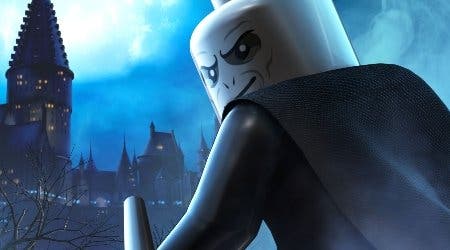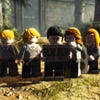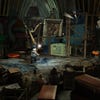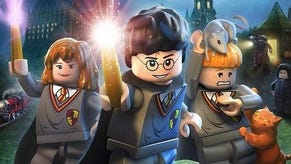Lego Harry Potter Years 5-7 Review
Stud-ent of Magic.
It's all in the wand. This tool of mystical power may be threaded with a phoenix feather in J. K. Rowling's ubiquitous mythology, but here, in the latest of Traveller's Tales' similarly successful mash-ups, its core is pure brick.
Create and destroy. These twin, conflicting concepts have fired Lego's success for over 60 years: the joy of building a plastic house only to knock it down again; the wonder of being able to rebuild a spaceship as a handgun or a robot as a kitten. The wand presses this same power into our palms.
A purplish glow hovers around clumps of bricks on screen as you point. Squeeze the button and the bricks hover and swirl before assembling themselves into a meaningful shape: a bridge, a staircase, a statue. Meanwhile, another button unsheathes the wand, not as a the tool of a creator, but as the weapon of a destructive god, firing magical bullets that disassemble those same objects into a dozen pieces, spitting out coins to collect.
Traveller's Tales may have established the fundamental mechanics in the Star Wars universe, but it's in Harry Potter's world that the concepts really click into place. A Jedi wields the Force of creation in a palm and the force of destruction in a lightsaber. In Lego Harry Potter, it's all in the wand. As such, there is a harmony of idea and expression that envelops the game.
This isn't the only happy correlation between the ideology of Lego and the mythology of Potter that helps make this the strongest of the developer's games. Rowling's world is held together with a mixture of magic and logic, the two key ingredients to any video game in search of fathomable wonder.
Broomsticks and cars can fly, but people can merely levitate; Chimneys offer warp points, but if there are none around, you must take the stairs or catch a lift. Green spells cause cloying vines to retreat, opening up new pathways or releasing objects, while white spells scare away ghouls. Harry Potter has an unflinching game logic, all keys, locks and hard-and-fast rules that can be written in C++. As such, in the right hands, this written world is ripe for turning into a video game.
A less straightforward challenge is steering a story through three books' worth of plot, all of which take place within the shifting structure of Hogwarts School. As with the previous Lego Harry Potter game, the structure is surprisingly complex and forward-thinking. There are, in effect, two hub worlds to explore, each leading into the six discrete levels that comprise each book's story.
The first, Diagon Alley, is where new characters are purchased, cheats are unlocked, videos are re-watched and previous levels are accessed. The second nested hub world is Hogwarts itself, a mystically mechanical building filled with shifting secrets that changes dynamically as you progress through the game. You follow a ghoulish guide through its corridors towards the trigger point for the next level, uncovering its own secrets en route as you gain access to new spells and abilities over the course of the adventure.
These environments have been reworked from the previous game, with new angles and details ensuring freshness for those who mined Years 1-4. Changes are also evident in the darker, more mature aesthetic (mimicking the same shift in the movies).
The core rhythms of the game are consistent with all of the Lego titles: short, sharp levels that require different character abilities to be used in order to progress, while a host of collectibles beg your distraction. But you are now able to cast spells freely without needing to sweep a reticle around the screen for a lock-on, while a clutch of new spells, puzzles, characters and a smart, dramatic duelling mini-game layer on micro-evolutions to keep what is now a very familiar formula interesting.
The cut-scenes are directed with typical flair, taking the Reduced Shakespeare Company approach to recounting the events of the film with compact glee. In truth, the story is impossible to follow if you don't have a firm grasp of the books' plot, but for those familiar with the story's key beats, the cut-scenes do a typically excellent job of communicating the arc with charm and condensed humour.
Traveller's Tales again displays its attention to fine detail as, for example, you find you cannot shoot Dolores Umbridge with a spell if you bump into her while wandering Hogwarts (your missiles simply divert around her), as to do so would surely see you expelled. At the same time, there's a willingness to allow you to be playful with the mythology - one scene inviting two players to have Professor Snape and Potter join one another on a seesaw ride in the playground.
This is comfortably the most stylish of the Lego games too, with flashback scenes rendered in de-saturated colours, while one Panzer Dragoon-esque fly over the River Thames early in the game is directed with wonderful flair. Indeed, Lego Harry Potter captures the essence of J. K. Rowling's stories in a way no other licensed game based on the mythology has managed - a testament to the team's directorial skill as well as their implicit understanding of what makes the series so beloved of children.
Nevertheless, there are times when the realisation sets in that, if you were to remove the copious collectible shopping lists, there would only be a slender game left. The lifeblood of the Lego games is the incessant pursuit of the collectible (and the way that gaining one collectible enables the capture of the next), and almost every interaction within the game feeds into this broad aim. Succumb to these demands and agree to fill in the litany of blanks (100-odd characters, 60 students in peril, 200 gold bricks, 24 school emblems and 20 game-enhancing cheats) and you will have fun curating your collection towards completion. But if your brain isn't wired like this, and blanks in a collection are less a gauntlet than a space to shelve your ambivalence, what's left is relatively slight.
Within the Lego legacy, however, Harry Potter Years 5-7 is arguably the strongest entry. The lack of ledges means that, in contrast to the Star Wars titles, falling to a coin-spilling death is a rarity for younger players, while Potter's world is filled with enough diversity to make every excursion feel unique and interesting.
Traveller's Tales continues to demonstrate its mastery of the local co-op form, the locked, directed cameras allowing two players to freely move around the screen without needing to wrestle with one another for a prime view on the action. Meanwhile, John Williams' iconic theme melds with Nicholas Hooper and Alexandre Desplat's distinguished scores from the later films to create a magical, nostalgic ambiance.
But the true wonder of the game is in its clockwork structure, the way dynamic story and environments that shift with time thread with the permanence of its collectibles and secrets. There is an intricacy of design here as impressive as any of the miniature towns on view at Legoland.
Now the Potter mythology is finished, Travellers' Tales' challenge is to break apart what it has so carefully constructed and rebuild it into a new shape, with new purpose and form. One wonders, however, if they will ever again find an IP so well suited to their designs as that of Harry Potter. It's all in the wand.










